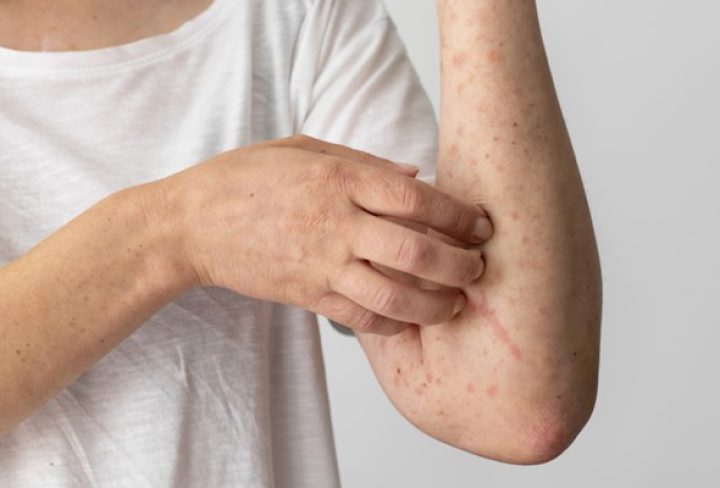Dermatitis is a skin condition characterized by inflammation, irritation, and/or itching.
It can be caused by a variety of factors, including allergies, irritants, and infections.
Common types of dermatitis include atopic dermatitis (eczema), contact dermatitis, seborrheic dermatitis, and stasis dermatitis.
Symptoms of Dermatitis
- Dry and itchy skin
- Redness and inflammation of the skin
- Blisters
- Scaling
- Crusting
- Bumps
People with dermatitis may also experience burning, stinging, and pain.
Causes of Dermatitis
Allergies: Allergies are the common cause of dermatitis and can be triggered by a variety of substances, including pollen, pet dander, dust mites, and certain foods.
Irritants: Certain chemicals, detergents, and other substances can cause the skin to become inflamed, leading to dermatitis.
Immune System Dysfunction: People with weakened immune systems may be more likely to develop dermatitis. This includes those with autoimmune diseases, such as lupus, or those who take medications that suppress the immune system.
Certain medical conditions: People with eczema, psoriasis, diabetes and other conditions are more likely to develop dermatitis.
Stress: Stress can worsen dermatitis symptoms and make them more difficult to control.
Temperature and humidity: Extreme temperatures and high humidity can trigger dermatitis flare-ups.
Family history: Those with a family history of dermatitis are more likely to develop the condition.
Diagnosis of Dermatitis
The diagnosis is usually based on physical examination of the affected area. During the physical examination, the doctor may look for signs of inflammation, such as redness, swelling, and itching.
The doctor may also take a sample of the affected skin to examine under a microscope. In some cases, they may also perform a biopsy to make a definitive diagnosis.
Treatment of Dermatitis
Dermatitis is caused by a variety of factors like irritants, allergens, or stress.
Treatment Criteria
- Avoid irritant or allergen
- Use mild soaps and moisturizers
- Use topical medications such as corticosteroids, antihistamines, or antibiotics, and phototherapy
Other treatments may include lifestyle modifications such as avoiding certain fabrics, eating a healthy diet, exercising, and reducing stress.
Preventive Measures of Dermatitis
1. Avoid contact with irritants: To prevent contact dermatitis, it is important to avoid any contact with the substances that trigger it. If you are aware of the substances that cause a reaction, take steps to avoid them.
2. Wear protective clothing: Wear gloves and other protective clothing when handling any substances that may cause a reaction, such as cleaning products or paints.
3. Practice good skin care: Keep your skin clean and moisturized to reduce the risk of dermatitis. Avoid long, hot showers or baths, and limit the use of soaps and detergents that can dry out your skin.
4. Use mild soaps: Choose mild soaps and detergents that are free of fragrances, dyes, and other additives.
5. Avoid allergens: If you are allergic to certain materials, such as latex or nickel, try to avoid contact with them.
6. Use sunscreen: Sun exposure can make dermatitis worse, so use sunscreen when outdoors.
7. Avoid scratching: Scratching can make the condition worse, so try to keep your skin cool and avoid scratching.
8. Choose hypoallergenic products: When choosing skin care products, look for ones that are labeled hypoallergenic.
Nutrition and Diet Changes for Dermatitis
1. Increase your intake of nutrient-dense foods. Eating fruits, vegetables, whole grains, lean proteins, nuts, and seeds can help provide your body with the vitamins and minerals it needs to help reduce inflammation.
2. Avoid foods that are known to trigger dermatitis flare-ups. Common trigger foods include dairy, wheat, eggs, and shellfish.
3. Increase your intake of omega-3 fatty acids. Omega-3s are anti-inflammatory and can reduce the symptoms of dermatitis. Good sources of omega-3s are fatty fish, flaxseeds, chia seeds, walnuts, and hemp seeds.
4. Increase your intake of probiotics. Probiotics can also help maintain a healthy balance of bacteria in the gut and can reduce inflammation. Good sources of probiotics are yogurt, kefir, sauerkraut, and kombucha.
5. Avoid processed and fried foods. These foods can increase inflammation and worsen the symptoms of dermatitis.
6. Stay hydrated. Drinking plenty of water can help reduce the symptoms of dermatitis.
Dermatitis: When to see a doctor?
If you have any signs of infection, such as:
- Increased redness
- Swelling
- Pus or pain
Also see a doctor-
If your dermatitis has not improved or worsened after following home care and self-care measures.
If you have any concerns about the severity or progression of your dermatitis.

